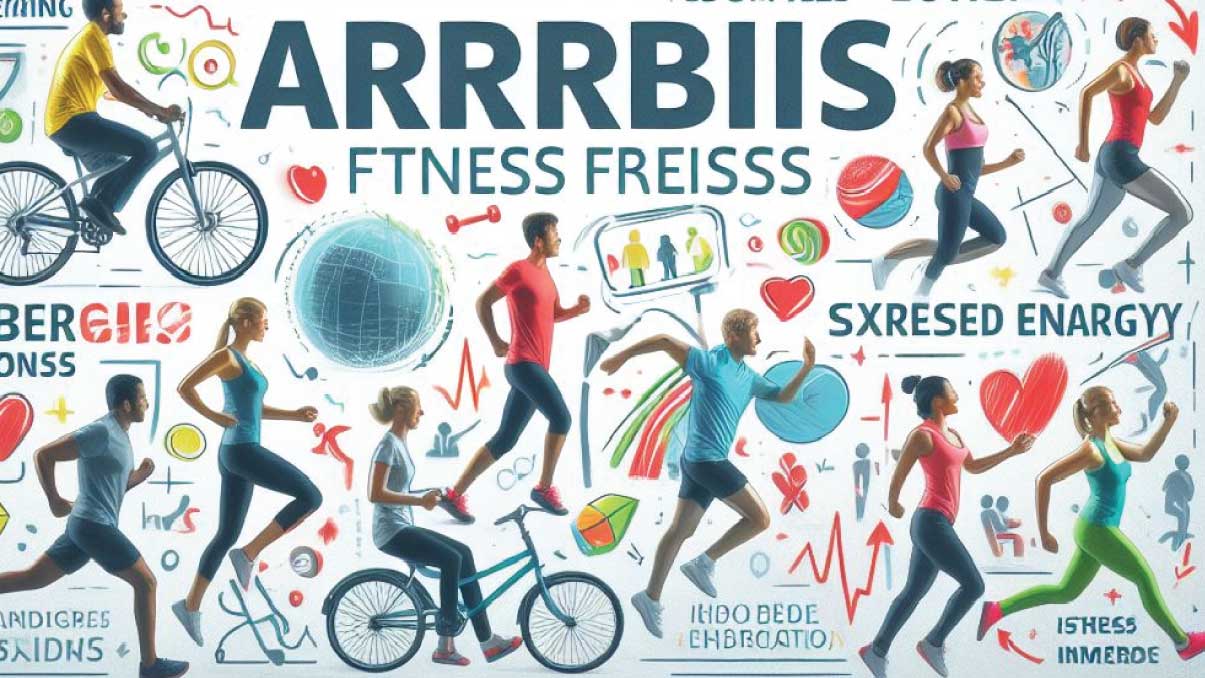Health related fitness exercises encompass activities that promote physical well-being, such as cardiovascular training, strength training, flexibility exercises, and mindfulness practices. These activities contribute to overall health, vitality, and longevity.
In today’s fast-paced world, prioritizing our health has become more crucial than ever. Incorporating fitness exercises into our daily routine not only helps us maintain physical well-being but also enhances mental clarity and emotional balance. With a plethora of options available, it can be overwhelming to discern which exercises yield the most significant benefits. Fear not! We have curated a comprehensive list of the 10 best health related fitness exercises that will empower you to embark on a transformative journey towards vitality and longevity.
1. Cardiovascular Training:
Cardiovascular exercises, such as running, cycling, and swimming, are paramount for enhancing heart health and improving overall endurance. Engaging in regular cardio sessions not only burns calories and aids in weight management but also strengthens the heart muscle, reduces the risk of chronic diseases, and boosts mood by releasing endorphins, the body’s natural mood elevators.
2. Strength Training:
Incorporating strength training into your fitness regimen is essential for building lean muscle mass, increasing bone density, and enhancing metabolic rate. Exercises like squats, deadlifts, and push-ups target major muscle groups, promoting functional strength and improving overall body composition. Additionally, strength training helps prevent age-related muscle loss and reduces the risk of injury by fortifying connective tissues.
3. Flexibility and Mobility:
Flexibility and mobility exercises, including yoga, Pilates, and dynamic stretching, are instrumental in improving joint range of motion, enhancing posture, and alleviating muscular tension. By incorporating these practices into your routine, you’ll experience greater ease of movement, reduced stiffness, and enhanced athletic performance. Moreover, flexibility training aids in injury prevention and promotes relaxation, fostering a deeper mind-body connection.
4. High-Intensity Interval Training (HIIT):
For those seeking to optimize their workout efficiency, HIIT offers a compelling solution. This dynamic training method alternates between short bursts of intense exercise and brief recovery periods, delivering a potent cardiovascular and metabolic stimulus in a fraction of the time. HIIT workouts, such as burpees, sprints, and jumping jacks, ignite calorie burn, improve insulin sensitivity, and elevate post-exercise oxygen consumption, facilitating continued calorie expenditure long after the workout concludes.
5. Functional Training:
Functional training focuses on replicating everyday movements and improving overall functional capacity. Exercises like lunges, kettlebell swings, and medicine ball throws engage multiple muscle groups simultaneously, enhancing coordination, balance, and agility. By integrating functional movements into your routine, you’ll develop strength and stability that translate seamlessly into daily activities, thereby reducing the risk of injury and enhancing overall quality of life.
6. Core Strengthening:
A strong core serves as the cornerstone of physical fitness, providing stability and support for the entire body. Core exercises, including planks, Russian twists, and bicycle crunches, target the muscles of the abdomen, lower back, and pelvis, improving posture, balance, and spinal alignment. By prioritizing core strengthening, you’ll not only achieve a sculpted midsection but also mitigate the risk of back pain and enhance functional movement patterns.
7. Balance and Stability:
Balance and stability training are vital for reducing the risk of falls, enhancing proprioception, and improving overall body control. Exercises such as single-leg stands, balance boards, and bosu ball exercises challenge the body’s ability to maintain equilibrium, thereby strengthening stabilizing muscles and improving coordination. By incorporating balance training into your routine, you’ll enhance athletic performance, reduce the risk of injury, and cultivate a greater sense of bodily awareness.
8. Mindfulness and Meditation:
In addition to physical exercise, prioritizing mindfulness and meditation is paramount for achieving holistic health and wellness. Mindfulness practices, such as guided meditation, deep breathing exercises, and mindful walking, promote stress reduction, emotional resilience, and cognitive clarity. By carving out time for quiet reflection and introspection, you’ll cultivate a profound sense of inner peace and tranquility, fostering optimal mental and emotional well being.
9. Endurance Training:
Endurance training challenges the body’s ability to sustain prolonged physical activity, thereby enhancing cardiovascular fitness and stamina. Activities like long-distance running, cycling, and swimming build aerobic capacity, increase mitochondrial density, and improve the body’s ability to utilize oxygen efficiently. By progressively increasing training volume and intensity, you’ll expand your endurance threshold, enabling you to tackle physical challenges with newfound vigor and resilience.
10. Recovery and Regeneration:
Last but certainly not least, prioritizing recovery and regeneration is essential for maximizing the benefits of your fitness routine and preventing burnout. Adequate rest, hydration, and nutrition are critical for muscle repair, glycogen replenishment, and hormone regulation. Incorporating rest days, foam rolling, and massage therapy into your regimen facilitates tissue repair, reduces inflammation, and optimizes recovery between workouts, ensuring sustained progress and long-term adherence to your fitness goals.
10 Amazing Benefits of Health Related Fitness Exercises:
Improved Cardiovascular Health:
Engaging in health related fitness exercises such as jogging, cycling, or swimming enhances heart health by increasing blood circulation, lowering blood pressure, and reducing the risk of heart disease and stroke.
Weight Management:
Regular physical activity helps regulate body weight by burning calories and increasing metabolism. Combined with a balanced diet, health related fitness exercises contribute to maintaining a healthy body composition and preventing obesity.
Enhanced Muscle Strength and Tone:
Strength training exercises like weightlifting or bodyweight exercises promote muscle growth, improving strength, endurance, and overall physical performance. Strong muscles also support better posture and reduce the risk of injuries.
Increased Bone Density:
Weight-bearing exercises such as walking, hiking, or resistance training stimulate bone formation, leading to increased bone density and reduced risk of osteoporosis, especially important as we age.
Improved Flexibility and Range of Motion:
Flexibility exercises like yoga or stretching routines help increase joint flexibility, reducing stiffness and improving overall mobility. Enhanced flexibility reduces the risk of injuries and promotes better movement patterns.
Boosted Mood and Mental Health:
Physical activity stimulates the release of endorphins, neurotransmitters that promote feelings of happiness and reduce stress, anxiety, and depression. Regular exercise also improves cognitive function and enhances overall mental well-being.
Enhanced Immune Function:
Moderate-intensity exercise boosts the immune system by promoting circulation, improving lymphatic flow, and increasing the production of immune cells. Regular physical activity can help reduce the risk of infections and chronic diseases.
Better Sleep Quality:
Engaging in regular health related fitness exercises has been shown to improve sleep quality by promoting relaxation, reducing insomnia, and regulating sleep-wake cycles. Adequate sleep is essential for overall health and well-being.
Increased Energy Levels:
Physical activity increases energy levels by improving oxygen delivery to tissues, enhancing mitochondrial function, and boosting overall metabolic rate. Regular exercise leads to increased vitality and reduced feelings of fatigue.
Longevity and Quality of Life:
Research consistently shows that individuals who maintain an active lifestyle tend to live longer, healthier lives. Health-related fitness exercises contribute to longevity by reducing the risk of chronic diseases, enhancing physical function, and promoting overall vitality and resilience.
Tips How to Include Health Related Fitness Exercises Into Your Life:
Set Realistic Goals:
Start by setting achievable fitness goals based on your current level of fitness and health status. Whether it’s increasing daily steps, adding strength training sessions, or committing to regular yoga classes, setting realistic goals will keep you motivated and focused on your journey to better health.
Schedule Regular Exercise Sessions:
Treat exercise as you would any other important appointment by scheduling it into your daily or weekly calendar. Choose a time of day when you’re most likely to stick to your workout routine, whether it’s before work, during lunch breaks, or in the evenings.
Find Activities You Enjoy:
Explore different types of fitness activities and find what resonates with you. Whether it’s hiking in nature, dancing to your favorite music, or practicing martial arts, choosing activities you enjoy increases the likelihood of long-term adherence to your fitness routine.
Mix It Up:
Keep your workouts interesting and challenging by incorporating a variety of exercises and activities. Alternate between cardio, strength training, flexibility, and balance exercises to target different muscle groups and prevent boredom.
Make It Social:
Invite friends, family members, or coworkers to join you in your fitness endeavors. Group workouts not only provide accountability but also foster a sense of camaraderie and support, making exercise more enjoyable and motivating.
Start Slowly and Progress Gradually:
If you’re new to exercise or returning after a hiatus, start with low-intensity activities and gradually increase the duration and intensity over time. Listen to your body and avoid pushing yourself too hard, as this can lead to burnout or injury.
Incorporate Exercise into Daily Routines:
Look for opportunities to sneak in physical activity throughout the day. Take the stairs instead of the elevator, walk or bike to nearby destinations, or do bodyweight exercises during commercial breaks while watching TV.
Invest in Proper Gear and Equipment:
Wear comfortable, supportive footwear and appropriate workout attire to enhance performance and reduce the risk of injuries. If engaging in specific activities like running or cycling, invest in quality gear and equipment that fits properly and meets your needs.
Stay Hydrated and Fuel Your Body:
Drink plenty of water before, during, and after exercise to stay hydrated and support optimal performance. Eat a balanced diet rich in nutrient-dense foods to fuel your workouts and aid in muscle recovery and repair.
Listen to Your Body and Rest When Needed:
Pay attention to how your body feels during and after exercise. If you experience pain, fatigue, or excessive soreness, take a break and allow your body time to rest and recover. Rest days are essential for preventing overtraining and promoting long-term fitness and health.
By incorporating these tips into your lifestyle, you’ll be well-equipped to embrace health-related fitness exercises and reap the numerous benefits they offer. Remember, consistency is key, so stay committed to your fitness journey and celebrate your progress along the way!
Conclusion:
Embarking on a journey to optimal health and fitness requires dedication, commitment, and a multifaceted approach. By incorporating the 10 best health related fitness exercises into your routine, you’ll unlock the transformative power of physical activity and cultivate a vibrant, resilient body and mind. Whether you’re a seasoned athlete or a fitness novice, there’s something for everyone in this comprehensive guide to holistic wellness. Start today and embrace the boundless potential of your body to thrive and flourish!

